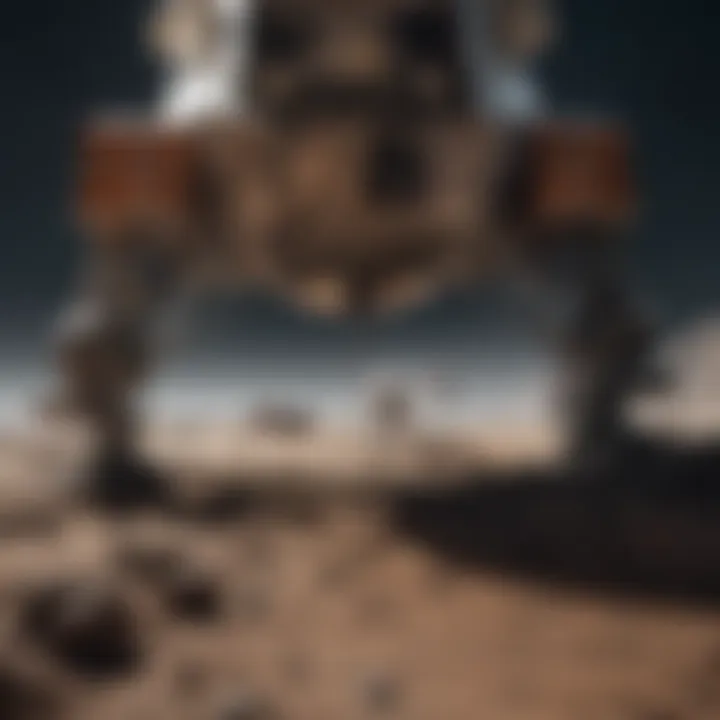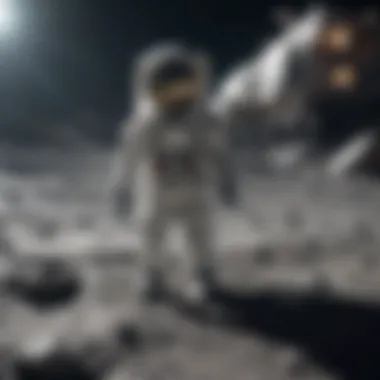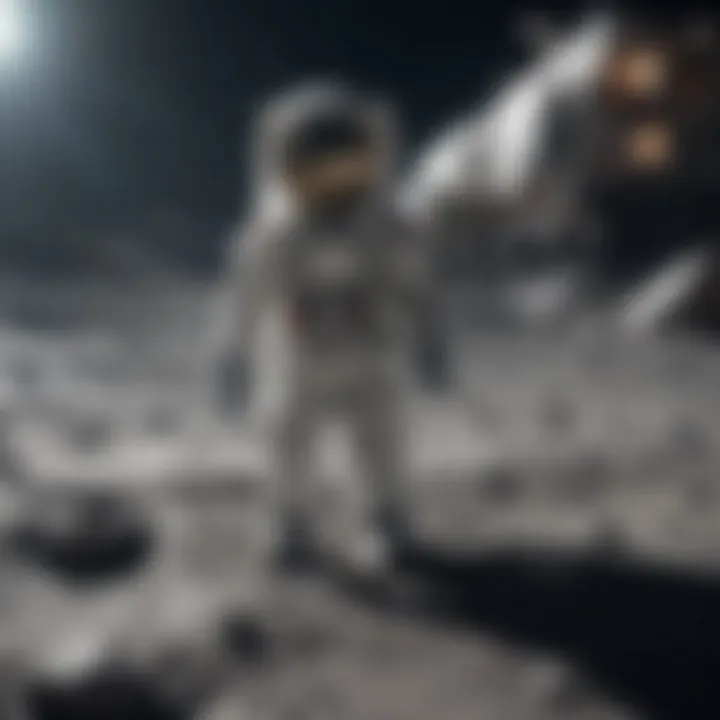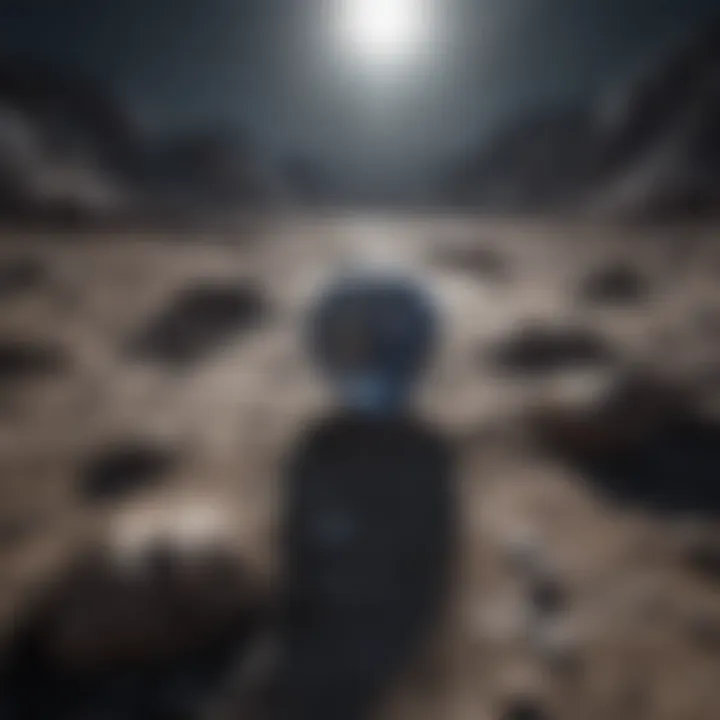The Moon Landing: Humanity's Historic Leap


Nature Topic Overview
The remarkable event of landing on the Moon is more than just a tale of human adventure; it’s a significant chapter in the story of exploration and curiosity. Picture this: a blue and green Earth floating in the vastness of space, and there, just a short distance away, lies the Moon—an object of wonder that has inspired folklore, legends, and scientific pursuits. On July 20, 1969, humanity took its first steps onto the lunar surface. Astronauts Neil Armstrong and Buzz Aldrin, aboard the Apollo 11 spacecraft, became the first human beings to walk on another celestial body. The implications of this mission were profound, not just in terms of technological achievement, but also in how we view our place in the universe and the possibilities that lie beyond our home planet.
Fun Facts and Trivia
To spark your curiosity about this grand adventure, here are some fun and interesting tidbits that capture the imagination:
- The Original Goal: While the primary aim of the Apollo program was to land on the Moon, it began as a quest to demonstrate American technological superiority during the Cold War.
- Lunar Footprints: The footprints left on the Moon could remain for thousands of years. Since there is no atmosphere, wind, or rain to wash them away, they serve as permanent reminders of human exploration.
- Moonwalking: Neil Armstrong and Buzz Aldrin spent just over two hours walking on the Moon, collecting samples, taking photographs, and conducting experiments.
"That’s one small step for a man, one giant leap for mankind." – Neil Armstrong
Wildlife Explorations
While the Moon might not seem like a place filled with wildlife, our excitement for exploration can relate to our understanding of terrestrial life. For instance,:
- Moon Lotus: While not a wildlife species, did you know about the Moon Flower? It blooms at night and resembles the beauty of lunar landscapes.
- Creatures of the Night: Just as the Moon has inspired us, the nocturnal animals back on Earth, like owls and bats, thrive in low-light conditions, reminding us of the wonder of adapting to different environments.
Environmental Awareness
Our journey to the Moon also serves as a reminder of how we treat our planet. The fragile beauty of Earth viewed from the Moon's surface brings an urgent message:
- Conservation Is Key: We need to take steps to protect our environment. Simple actions, like recycling and planting trees, can go a long way.
- Space Debris: Just like we take care of our backyard, we should think about space too! The remnants of rockets and missions clutter our near-space environment.
DIY Nature Activities
Learning about the Moon and our planet can be a hands-on adventure! Here are some activities to explore:
- Create Your Moon Crater: Use a tray filled with flour and sprinkle cocoa powder on top. Drop small rocks from different heights and observe the craters formed!
- Moon Phases Art: Use a black paper to draw out the phases of the Moon using white chalk or a crayon.
- Night Sky Observations: Spend an evening stargazing. Use binoculars or a telescope to spot the Moon and identify any visible constellations.
By understanding and appreciating the Moon landing, we motivate ourselves to seek curiosity and innovation while protecting our unique planet. Our exploration beyond Earth teaches us not just about the universe, but also about the value of cherishing the home we have.
Intro to the Moon Landing
The moon landing is one of those rare moments in human history that changed everything we knew about our place in the universe. It wasn't just about planting a flag on lunar soil; it marked the beginning of an era where the sky was no longer the limit. The epic voyage to the moon taught us how to overcome obstacles, both in technology and in human spirit, paving the way for future explorations into the great unknown.
Historical Context
The backdrop to the moon landing begins in the context of fierce rivalry during the Cold War. In 1961, President John F. Kennedy famously stated that America would land a man on the moon before the decade was out. This announcement was both a challenge and a goal that ignited interest and energy across a nation. Following this, NASA's Apollo program was born, which would be the primary vehicle for achieving this monumental feat. The race against the Soviets was more than just about victory; it was about demonstrating technological superiority and the prowess of democratic ideals.
As scientists worked tirelessly, advancements in rocketry, navigation, and even computer science began pouring in. The culmination of years of hard work came in July 1969, when Apollo 11 successfully landed on the moon. At that moment, Neil Armstrong and Buzz Aldrin became the first humans to step onto a surface beyond Earth, forever changing how humanity viewed itself.
Importance of Space Exploration
Exploring space is not merely about stretching our legs beyond the familiar; it's about fueling curiosity. Why does the moon matter? Because it offers answers to questions we've been asking since time immemorial, like how did our solar system form? What is the potential for human life beyond Earth?
The moon serves as a testing ground. Just consider:
- Robotics and Technology: The tools and instruments used on the moon led to breakthroughs back here on Earth. Modern satellite communication, GPS, and even some medical technologies were derived from looking skyward.
- Global Collaboration: Space exploration unites nations. Projects like the International Space Station show what can be achieved when we work together towards a common goal.
- Inspiration for Future Generations: For every child who gazes up at the night sky, the moon landing plants a seed of ambition—teaching kids that they can reach for the stars, literally and figuratively.
"Space exploration is a force of nature unto itself that no other force in society can rival."
In essence, the moon landing wasn’t just an event; it was a turning point, a humble reminder that with hard work and cooperation, we can reach unimaginable heights. With each revelation from space, our understanding of life, the universe, and ourselves deepens, making space exploration not just an event of the past but a continuous journey into the future.
Preparations for the Mission
The journey to the Moon was no ordinary road trip. It was a monumental endeavor that required immense planning and preparation. Each detail mattered, from selecting the right equipment to training the astronauts, ensuring everything went smoothly. When you think about it, preparing for such a mission is a bit like building a house; if the foundation isn’t solid, everything can come crashing down. This section dives into the core aspects of preparation that paved the way for one of humanity’s greatest achievements.
The Apollo Program
The Apollo Program was born from the desire to challenge the unknown and push the limits of what we understood about space. Administered by NASA, this ambitious project aimed not just to reach the Moon but also to return safely to Earth. It encompassed a series of missions, each carefully designed to take on different challenges, collect valuable data, and refine technological advances. So many people worked behind the scenes, engineering tools and systems that would ensure astronauts were safe. It was like a massive orchestra, where each musician’s performance counted toward the grand symphony of a successful mission.
Selecting Astronauts
Selecting the right astronauts might feel like picking a team for a serious sports tournament. The astronauts were not just brave; they also needed to possess a range of skills and backgrounds. Factors included experience in flying jets, scientific training, and even physical fitness. It was all about finding individuals who could handle the mental and physical rigors of space travel. Ultimately, the crew would be the face of this courageous endeavor, representing not just themselves but all of humanity in the grand act of exploration.
Training for the Mission
Training for the moon landing was meticulous and exhaustive, involving several elements. Astronauts had to prepare for every scenario, knowing that anything could happen once they left Earth’s atmosphere. Let’s break down a few crucial aspects of their training:
Simulations and Drills
Simulations and drills were a centerpiece of astronaut training. Think of them as rehearsals for a big play, where every movement and line is practiced until it's perfected. This method allowed astronauts to familiarize themselves with the spacecraft and its systems before they were actually in space. The key characteristic about these simulations was their realism. Many drills mimicked actual flight conditions, including handling emergencies like a fuel leak or a system failure. Such preparedness was indispensable, bringing astronauts confidence in their abilities.
The unique feature of these drills was that they were often conducted in a controlled environment, which helped astronauts experience the stress and unpredictability of space missions without the actual risk. However, one disadvantage could have been that they sometimes could not fully replicate the disorientation caused by zero gravity.
Physical Fitness
Physical fitness was another critical pillar of training. Astronauts faced unique challenges in space, and a well-conditioned body was essential. They had to build strength and endurance that would protect them against the physical demands of launch, landing, and the Moon's surface. Training involved weightlifting, cardio, and even activities designed to acclimate their bodies to zero gravity. The benefit of maintaining fitness was clear: it kept the astronauts healthy and prepared their bodies for the rigors they would encounter. However, the downside was that this intense physical focus sometimes left little room for other types of preparation, like emotional readiness, which is also greatly important.
Technical Skills
Mastering technical skills was perhaps the most critical aspect of an astronaut’s training. They were like engineers and pilots rolled into one, needing to fix complex machines at a moment's notice while managing life support systems. Astronauts learned to work on the spacecraft, understand navigation systems, and operate scientific instruments they’d use during the mission. This comprehensive technical training ensured that they would be able to tackle any problem that arose. The distinctive feature of this training was its hands-on approach, with astronauts tinkering with equipment, fixing issues under guidance, and learning to trust their intuition. However, a potential drawback was the steep learning curve; not every astronaut grasped these technical complexities quickly, which meant varying levels of preparedness within a crew.


Preparing for the Moon landing required a delicate balance of physical, technical, and psychological readiness. With each layer of preparation, astronauts and the ground crew took one step closer to making history. As we dive into the journey itself, these foundations will reveal how critical such preparations were for the mission's success.
The Launch
The launch is a crucial chapter in the story of space exploration. This is the moment when everything comes together; a culmination of years of research, development, and determination. Without a successful launch, no mission can reach the immense distances posed by space, particularly the Moon. It involves a series of magical and technical feats that defy the ordinary limits of human achievement.
Countdown to Launch
As the countdown clock ticks down, excitement hangs thick in the air. Engineers and scientists, often in teams, work tirelessly, ensuring every detail is perfect. This process is not just about pointing a rocket skyward; it’s about coordinating thousands of moving parts. Think of it like a big, delicate orchestra where every instrument must hit the right note at the right time.
During the final hours leading up to launch, teams check and double-check the systems. They run through simulations and drills to make sure that everyone knows their role. Each minute before the launch is electric with anticipation.
Once the countdown reaches zero, a roar echoes as the engines ignite. The rocket, filled with fuels and dreams, leaps from the ground, scratching the sky.
Rocket Technology
Rocket technology is the backbone of any space mission. It’s not just about getting off the ground; it’s about the entire journey through the darkness of space. This technology has evolved dramatically over the years, pushing the boundaries of what is possible. Understanding the components of a rocket sheds light on how missions are able to reach their breathtaking destinations.
Parts of the Rocket
A rocket is a remarkable machine made up of various parts that work together seamlessly. At its core, every rocket comprises four main components:
- Propulsion system: This is the heart of the rocket. It generates the necessary thrust to escape Earth's gravity.
- Structure: Built to withstand intense forces, it houses all the other parts, protecting them from damage during launch.
- Payload: Often containing satellites or, in the case of crewed missions, astronauts – this is what the rocket is ultimately delivering.
- Control systems: These are critical for guiding the rocket through its journey. They help steer and maintain the desired trajectory.
Each of these parts plays a vital role. For instance, the propulsion system features a powerful rocket engine that burns fuel to produce thrust. Its design is a beneficial choice because it has been honed through countless launches to maximize efficiency.
One unique feature of modern rockets is their reusable components. Companies like SpaceX have developed rockets that return safely to Earth for reuse, reducing the cost of subsequent missions. However, this also comes with disadvantages, such as the complexity involved in refurbishing rocket parts for upcoming launches.
Propulsion Systems
Propulsion systems are truly the unsung heroes of space missions. These systems define how a rocket escapes Earth’s pull and maneuvers in the vacuum of space. Chemical propulsion, which burns solid or liquid fuel, and electric propulsion, which uses electric fields, are the two main types.
What makes chemical propulsion particularly exciting is its key characteristic of producing a massive amount of thrust almost instantly. This is vital for getting past Earth's atmosphere and into orbit. Such systems have a long history of use and reliability, making them a popular choice for many space missions.
However, it comes with drawbacks, such as the limited fuel that can be carried. This often requires careful planning for any further maneuvers once in space.
In contrast, electric propulsion systems, while slower to accelerate, are extremely efficient. They can operate for long periods, making them advantageous for journeys to distant destinations. Their reliance on electricity is a beneficial trait as it allows for deep-space missions without heavy fuel loads.
Each propulsion system presents different characteristics that can serve various mission needs. Their selection is based on understanding the mission’s goals and potential challenges ahead.
"A successful launch is not the end but merely the beginning of a greater journey into the cosmos."
Understanding these elements not only enriches our appreciation for the technology involved but also highlights humanity's ability to dream and achieve what once seemed impossible.
Journey to the Moon
The journey to the Moon stands as a defining chapter in the tale of human curiosity and ambition. This segment holds great significance, as it underscores the monumental passage through the cosmos that separate our little blue planet from its shining lunar companion. Understanding the details of this voyage sheds light on the broader themes of exploration and perseverance that resonate throughout our history.
One key element of this journey is the sheer distance involved. Traveling approximately 238,855 miles (384,400 kilometers) to reach the Moon was no small feat, especially considering the technology available at the time. This extensive distance is not simply a number; it symbolizes the pioneering spirit that pushed humanity into uncharted territories. Additionally, the time it took—around three days of travel—further exemplifies the advancements made in aeronautics and engineering.
Traveling through Space
Distance and Time
When discussing distance and time, we really hit the nail on the head. The great expanse that astronauts covered was an achievement that required careful planning and execution. These measures ensured not just the success of the mission but also safeguarded the lives of those on board.
The distance traveled is particularly remarkable. Unlike anything encountered before, it necessitated innovations in spacecraft design and propulsion systems. To glide through the void of space with precision and reliability was no easy task.
- Key characteristic: Speed of spacecraft. The Apollo missions traveled at roughly 3,000 miles per hour.
- Unique feature: The journey took astronauts through varying gravitational pulls, influencing their speed and trajectory.
While the time took might seem relatively short to us now, back then, it involved meticulous calculations, risks, and, importantly, a fair share of patience. After all, each hour in space brought its own challenges—from zero gravity to cabin conditions that changed with distance to the Moon.
Experiences in Zero Gravity
Experiencing zero gravity was tantamount to exploring a different realm of existence. Floating in this weightless state brought a unique set of thrill and complications for the astronauts. Beyond the joy of weightlessness, this phenomenon also affected how they performed tasks during the mission.
- Key characteristic: Movement in zero gravity requires different techniques. For instance, astronauts learned to push off surfaces to change direction, a far cry from walking on Earth.
- Unique feature: Fluid dynamics behave differently in space; liquids form spheres, which can be quite mesmerizing to watch.
While the feeling of weightlessness has been described as wonderfully liberating, it also posed challenges. For example, drinking a simple glass of water becomes a much more complex affair in a liquid sphere. Without careful handling, even the simplest tasks could turn into mini-adventures.
Approaching the Moon
As the spacecraft neared its destination, the excitement intensified. The approach required intricate calculations to ensure a smooth descent and landing on the lunar surface. Astronauts faced the reality of conducting such delicate maneuvers in an environment entirely foreign to human life. It was a mix of science, engineering, and a sprinkle of intuition.
The experience of closing in on the Moon brought both awe and a sense of responsibility. As they witnessed the lunar surface gradually fill their viewports, the astronauts knew that every second counted. Their approach was not just a journey; it was the culmination of hard work, dreams, and sacrifices made over countless years.
Touchdown on the Moon
Touching down on the Moon marked a monumental occasion in humanity’s history. This event was not just a technical achievement, but also a monumental leap in our understanding of space exploration. The landing represented the triumph of human ingenuity and persistence. In this section, we’ll delve into various elements that contributed to the success of the lunar landing and what it meant for both science and society.
Landing Techniques
The methods used for landing on the Moon were advanced and remarkable. NASA utilized the Lunar Module, a specialized spacecraft designed for navigating the lunar terrain. The key techniques included:


- Controlled Descent: The Lunar Module executed a powered descent, which allowed astronauts to slow down safely as they approached the lunar surface.
- Landing Gear: Equipped with shock-absorbing struts, the gear helped cushion the landing, ensuring a smooth touchdown despite the Moon's rocky surface.
- Visual Guidance Systems: Astronauts relied on both onboard instruments and visual cues to execute a precise landing. This combination was crucial to avoid hazardous terrains.
The mastery of these landing techniques was essential, laying the groundwork for future travel beyond Earth.
First Steps on Lunar Soil
Once the Lunar Module landed, it was time for a giant leap! This moment was filled with anticipation as Neil Armstrong prepared to take the first steps on lunar soil. His experience on a foreign celestial body painted a fascinating picture of exploration.
Neil Armstrong's Words
When Armstrong stepped onto the Moon, he famously said, "That's one small step for man, one giant leap for mankind." This phrase became iconic, encapsulating the essence of human exploration and achievement. The words evoke feelings of hope and motivation, showing how courage can push boundaries.
- Key Characteristic: Armstrong's words were simple yet profound, rooted in a moment of genuine human emotion. They resonate with anyone pursuing big dreams.
- Unique Feature: By framing the achievement in both personal and collective terms, it emphasized that this journey was not just about one man, but about all of humanity.
In this article, discussing Armstrong's words is important because they reflect the spirit of exploration, inspiring young readers to think of their own adventurous pursuits.
Historical Significance
The historical significance of the Moon landing extends far beyond the moment itself. It represented the height of human cooperation and scientific progress. The mission had several vital aspects:
- Impact on Global Relations: The success of the Apollo 11 mission fostered a sense of unity, even amid the Cold War tensions. It showed that through collaboration and shared vision, humanity can achieve extraordinary goals.
- Technological Advancement: The technologies developed for this mission spurred advancements in numerous sectors, such as telecommunications and materials science.
- Continuing Legacy: The impact of the landing continues today, as it inspires current and future missions to the Moon and beyond. It has become a touchstone for space enthusiasts and scientists alike.
Discussions around historical significance are crucial as they illuminate the importance of human exploration and encourage kids to dream big. By showing how one event can change the course of history, young readers can understand that they too can achieve great things.
Exploration Activities
Exploration activities on the Moon were not just about planting flags or taking photographs; they were central to understanding our nearest celestial neighbor. Each mission involved meticulous planning and execution to ensure that astronauts could gather valuable data and materials that would open new doors in scientific research. Exploring the Moon allows us to piece together the puzzle of our solar system's history, and it serves as a platform for testing technologies vital for future endeavors, including potential human settlement.
Collecting Samples
Types of Samples
When astronauts collected samples during the Apollo missions, they gathered a variety of materials, each serving a unique purpose in scientific studies. The most notable types included:
- Lunar Soil (Regolith): This dust and fragmented rock cover the Moon’s surface. It's essential for studying the geological processes that shaped the Moon and understanding solar wind interactions.
- Lunar Rocks: Different kinds of rocks, such as basalt and breccia, were retrieved. These provide insights into volcanic activity and impact events on the Moon.
- Core Samples: Extracted from deeper layers, core samples help scientists understand the Moon’s internal structure.
One important characteristic is that these samples can be analyzed for their chemical and mineral content, which reveals significant information about the Moon's formation. The advantage of using these diverse sample types lies in their potential to unravel geological history and indicate how the Moon's evolution relates to Earth.
Scientific Analysis
The scientific analysis of the samples collected on the Moon represents a monumental step in lunar science. Once back on Earth, scientists used advanced methods such as:
- Mass Spectrometry: To measure isotopic compositions, providing insights into the age and origin of lunar materials.
- X-ray Diffraction: To understand the minerals and crystalline structures in the samples.
A key feature of scientific analysis is the ability to compare lunar samples with Earth’s materials. This comparison heightens our understanding of planetary processes, including the theory of a common origin for the Earth and Moon systems. However, the challenge here is that each analysis takes time and requires sophisticated technology, making it resource-intensive but highly rewarding.
Conducting Experiments
Conducting experiments on the Moon was groundbreaking because it opened avenues to test our theories in an environment unlike any on Earth. Experiments ranged from simple soil tests to complex scientific setups evaluating the Moon's gravity and radiation levels. The results from these experiments continue to influence our understanding of not only the Moon but also the broader cosmos.
By reaching out beyond our planet, we not only discover new worlds but also gain invaluable insights into our own place in the universe.
Life on the Moon
Understanding life on the Moon captures the imagination across all ages. It raises questions about survival, adaptation, and the unique challenges posed by such an alien environment. Insights into life on the Moon are not just about what could be, but also about what has already been achieved and what lies ahead. This inquiry touches on various aspects like the lunar environment and human physiology in a way that makes it relatable and engaging for young learners.
Lunar Environment
Gravity and Atmosphere
The Moon is fascinating because it has a very different gravity compared to Earth. With about one-sixth of Earth's gravitational force, it changes how astronauts move and interact with their surroundings. If you jump on the Moon, you'd float higher and stay in the air longer than you could on Earth. This property is essential, as it affects everything from how astronauts maintain their balance to how they conduct experiments.
The Moon lacks a significant atmosphere. This becomes a crucial characteristic because it means there is no air to breathe and no protection from solar radiation. While this drawback makes it a challenging space for humans, it also provides opportunities for unique astronomical observations. The night sky is clearer than on Earth, allowing for potentially groundbreaking discoveries.
Key characteristic of the Moon’s gravity and atmosphere:
- Low gravity allows for unique physical experiences, which might seem fun but can be perilous in terms of mobility.
- Lack of atmosphere poses serious risks but also benefits for space research.
Temperature Extremes
The temperatures on the Moon vary drastically. During the day, it can be scorching hot, reaching around 127°C (260°F). At night, it can plummet to a frigid -173°C (-280°F). This range poses significant challenges for human life. Imagine trying to wear a space suit that keeps you cool during the heat but also warm enough when it's freezing!
The unique feature of temperature extremes is clear: it creates an environment where life, as we know it, can't exist without proper technology. Engineers and scientists have to think of creative solutions to combat these extremes. Understanding how to work in such conditions can help shape future missions, including potential habitats for humans.
Key characteristic of temperature extremes:
- Harsh conditions can be seen as a disadvantage for human presence.
- Insights from these extremes can enhance future technologies for lunar exploration and beyond.
Effects on the Human Body
Being on the Moon has various effects on the human body that can be both fascinating and concerning. In reduced gravity, our muscles and bones don’t have to work as hard, which may lead to muscle atrophy and bone loss. This situation is like being on a long vacation but with less physical activity – not ideal for maintaining health!
Moreover, the lack of atmosphere increases exposure to radiation, which can have long-term health consequences. Astronauts must wear protective suits to shield themselves from those invisible dangers. While it’s thrilling to think about new frontiers, scientists find that the human body has some limits!


In summary, life on the Moon includes challenges posed by its unique environment, gravity, and temperature extremes. Understanding these factors is crucial to ensure the safety and success of future lunar missions.
"Understanding life on the Moon is not only about survival but also about unlocking mysteries of space and human adaptability."
Life on the Moon teaches us that exploration requires ingenuity and resilience. It also offers a fascinating glimpse into what living and working on another celestial body might really be like.
The Return Journey
The return journey from the Moon is a crucial climax in the story of the Apollo missions. After planting their boots on the dusty lunar surface and collecting samples, the astronauts faced a significant challenge: getting back home. This step not only marked the conclusion of their lunar adventure but also highlighted the precision and planning required in space travel. It's a journey that brings together science, engineering, and the resilience of the human spirit.
Launch from the Moon
Once it was time to return, the astronauts had to board their lunar module for the ascent back to the Command Module orbiting above. This launch from the Moon wasn’t simply about firing up engines; it included careful calculations and procedures.
- Preparation: Before leaving, the crew ensured they had all their samples and equipment safely stowed.
- Ignition Sequence: They had to follow a precise launch sequence to fire the ascent engine, launching themselves off the lunar surface. Any small mistake could result in catastrophic consequences.
- Separation from the Lunar Module: After the launch, the lunar module had to separate safely from the descent module, which was left behind.
The moment the lunar module launched is not just another tick in a checklist. It's a reminder of how far humans can reach, lifting off from a place that was once just a silvery speck in the night sky.
Re-Entry to Earth's Atmosphere
The ride back home involved navigating the inhospitable pathways of space, and the final stretch—re-entry—was possibly one of the most intense phases. As the crew made their way back to Earth, several factors played into the safety of their return.
- Angle of Re-Entry: A perfect angle was vital. Too steep, and they would burn up in the atmosphere; too shallow, and they would skip off like a stone on water.
- Heat Shield: The spacecraft was fitted with a protective heat shield designed to withstand extreme temperatures generated during re-entry. This shield absorbed and dissipated the heat, protecting the astronauts inside.
- Parachute Deployment: The final descent involved deploying parachutes to slow down the capsule, allowing for a safe landing in the ocean.
"Re-entry is like a roller coaster ride in slow motion. You’re capturing the thrill of coming back home, but you have to stay calm and trust the technology."
The return journey encapsulates the entire Moon landing experience, highlighting the incredible complexity of space travel. It’s a reminder that the effort doesn’t end when you leave the lunar surface; rather, it’s a pivotal part of the journey, demonstrating the full cycle of exploration and discovery.
As the world eagerly awaited their arrival, this phase united humanity in shared anticipation, showcasing not just the achievement of science but also the unyielding spirit of adventure.
Legacy of the Moon Landing
The moon landing stands as a monumental chapter in human history, marking a significant leap in our understanding of space and our capabilities as a species. The legacy of this event goes beyond just the achievement itself; it has shaped the very fabric of science, technology, and culture. The ripples of that historic day in 1969 continue to influence contemporary society and future endeavors in space exploration.
Impact on Science and Technology
The achievements from the Apollo missions propelled advances in various scientific fields. The techniques and technologies developed during this time have had a lasting impact on everything from engineering to medicine. After all, tackling the challenges of moon travel meant inventing new materials and systems to withstand extreme conditions.
- New Technologies: Innovations like portable life support systems paved the way for improved emergency care equipment.
- Computers: The computers used on the Apollo missions were primitive by today's standards, yet they laid the groundwork for modern computing. The guidance systems developed were some of the earliest steps toward precision navigation systems.
- Materials Science: Research into materials to protect astronauts also led to the creation of better insulations and fire-resistant clothing, which we utilize today in everyday life.
"The moon landing required not just courage, but creativity and ingenuity that led to advancements that are now second nature to us."
These scientific breakthroughs directly improved lives on Earth. In medicine, for instance, technology derived from space missions has been used in MRI machines and other diagnostic tools. Therefore, the legacy of the moon landing isn’t merely in lunar rocks but in the advancements to our health and safety systems.
Cultural Influence
The moon landing didn't just alter our technological landscape; it transformed our cultural narrative as well. It ignited a sense of wonder and possibility in people's minds, transcending geography, culture, and age groups generally.
- Inspiration for Generations: Images of astronauts walking on the lunar surface inspired not only scientists but anyone dreaming of what they can achieve. Children saw a world where they could explore beyond the horizon.
- Art and Media: The fascination with the moon landing found its way into films, books, and songs. These stories often depict not just the excitement of space, but the human spirit's quest for discovery. Classic movies like 2001: A Space Odyssey and songs like Rocket Man reflect a society captivated by the idea of space travel.
- Global Cooperation: In its quest for space, humanity found common ground. The extraordinary accomplishment united people around a shared goal and imagination, much like how sports can bring countries together. It reminded all of us that despite our differences, we all share the sky above.
The legacy of the moon landing serves as a powerful reminder. It teaches us that when humanity sets its sights on a goal, particularly one so grand as exploring the unknown, the outcomes can ripple through time in ways we are only beginning to understand.
Future of Moon Exploration
The future of lunar exploration is not just a shot in the dark; it’s a journey fueled by hope and curiosity, bridging the gap between dreams and reality. With the moon being the closest celestial body, it acts as a springboard for humanity's deeper dive into space. The next steps are not just about footprints in the dust; they are about setting the stage for new technologies, scientific discoveries, and perhaps even human life beyond Earth.
Ongoing Missions
Several countries and organizations are rolling up their sleeves to explore the moon more thoroughly than ever before. Missions like NASA's Artemis aim to land the first woman and the next man on the lunar surface by the mid-2020s. This is not just a return to the moon; it is about establishing a sustainable human presence.
Other initiatives include the European Space Agency's lunar missions which focus on understanding the scientific potential of the moon. Each mission reaffirms that the moon is ripe for exploration, offering clues to the formation of the Earth and the dynamics of our solar system.
- NASA's Artemis Program
- Chandrayaan Missions by ISRO
- China's Chang'e Program
- A series of missions aiming for sustainable exploration.
- Emphasis on lunar research and technology testing.
- India's ongoing efforts to explore the moon.
- Focus on sample collection and lunar research.
These ongoing missions are more than just fancy spacecraft heading to the moon; they are vital for gathering data and developing technologies that will pave the way for a potential human settlement.
Plans for Human Settlement
Planning human settlement on the moon is a monumental task, much like piecing together a puzzle. Scientists and engineers from around the globe are grappling with questions about habitability, sustainability, and how to transport resources. Establishing a presence on the moon could also serve as a launch pad for trips to Mars and beyond.
Here are some key considerations:
- Building Basics:
- Sustainable Living:
- Scientific Research:
- Exploring what materials can be utilized directly from the lunar surface to create habitats.
- Developing systems that allow humans to live off the land, relying on local resources for water and energy.
- Ongoing studies will help us understand how prolonged exposure to lunar conditions affects the human body, paving the way for longer space missions.
"The moon is not just a destination; it’s the first step outside our front yard into the vast universe."
So, as we look into the next decade and beyond, the moon shines as a beacon for opportunity. Engaging in lunar exploration is geared not just toward scientific understanding, but towards a larger vision of humanity's place in the cosmos. In this captivating era of space exploration, the moon will undoubtedly remain at the forefront of our celestial ambitions.







